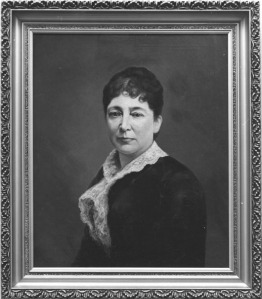The Palmers
The Palmers
Excerpted from the 2011 guide book for the Tour of Palmer Park and Historic Palmer Park Apartment District
by Gregory C. Piazza

Senator Thomas W. Palmer, above and Lizzie Merrill Palmer, below. Photos courtesy of the Freer House, Merrill-Palmer Audio-Visual Archive, Walter P. Reuther Library, Wayne State University
In 1832 Judge James Witherell (1759-1838), grandfather of Thomas W. Palmer (1830-1913) and the third Michigan Territorial judge, bought 80 acres of then-country land that ran from Hamilton Avenue to Fairway Drive. Witherell built a summer log cabin at what is now McNichols (Six Mile) and Log Cabin Street, named after the trail ending at Witherell’s cabin (not the cabin that is currently in Palmer Park). Witherell left the 80 acres to his daughter Mary Palmer when he died in 1838, and Mary, in turn, passed it on to her son Thomas W. Palmer in 1874.
Palmer expanded his inherited acreage to some 640 acres extending from what is now McNichols (Six Mile) to Eight Mile and Woodward Avenue to Fairway Drive. On this land, Palmer built a large farm and raised prize Percheron and Arabian horses.
Thomas W. Palmer has come to be considered one of the most significant figures in Detroit history. He was born in Detroit, educated at Thompson’s Academy in St. Clair, Mich., and studied at University of Michigan for a year. Palmer worked in the real estate business in Detroit before becoming involved in lumbering and agriculture.
In 1855 he married Elizabeth (Lizzie) Pitts Merrill (1837-1916), the daughter of one of his business partners, Charles Merrill, who was a noted businessman with large holdings in lumber. The Palmers would adopt four children: Harold (aka Higinio, Hidalgo), Betita, Lizzie and Gail.
Palmer served on the first board of directors and was first president of the Michigan Society for the Prevention of Cruelty to Animals (now Michigan Humane Society). He served on the Detroit Board of Estimates in 1873, was a member of the Michigan Senate from 1879 to 1880, and served on the U.S. Senate from 1883 to 1889.
While in Congress, Palmer was known as an advocate for women’s suffrage, immigration restrictions, and homesteader rights. His motto was “equal rights for all, special privileges to none.” On Feb. 6, 1885 he delivered a speech arguing in favor of a Constitutional amendment granting women’s suffrage. Palmer was appointed Minister to Spain in 1889 by President Benjamin Harrison and served until 1890. Palmer was president of the National Commission on the World’s Columbian Exposition from 1890 to 1893.
Both of the Palmers were among the major benefactors of the Michigan Soldiers and Sailors monument in Campus Martius. They were also among the first founders of the Detroit Museum of Art (now the Detroit Institute of Arts, DIA) and the Senator was its first president.
In 1864 the Palmers built a grand house on Woodward and Farnsworth, where the south wing of the DIA is today. That house burned in 1893. The land was later donated to the Art Museum. For a time the Palmers lived in the Log Cabin which was a fully functional house. Senator Palmer contracted with Mason and Rice in 1893 again to build Walnut Lane at what is now Whitmore and Second, where Unity Institute of Holistic Living stands today.
In her final years, Sen. Palmer retired to their Detroit farm, and Lizzie Merrill Palmer retired to their estate in Great Neck, New York. Senator Palmer died in 1913 from injuries incurred in a car accident. Mrs. Palmer died in 1916 in Great Neck. Lizzie Merrill Palmer’s estate was estimated to be worth $5 million, with a substantial portion (including land that is now the apartment district) designated for the establishment of the Merrill Palmer Institute for Motherhood and Home Training. Now known as Merrill Palmer Skillman Institute, it is part of Wayne State University.





Comments
One Response to “The Palmers”Trackbacks
Check out what others are saying...[…] Thomas expanded the family’s holdings, eventually owning some 640 acres. This is roughly the area from Woodward and Six Mile to Woodward and Eight Mile, Six Mile to Fairway, up to Eight Mile and to Woodward. Palmer developed a farm where he raised prize Percheron horses. In 1855 Palmer married Elizabeth (Lizzie) Pitts Merrill (1837-1916), daughter of Charles Merrill a noted businessman with large holdings in lumber. The Palmers would adopt four children: Harold (aka Higinio, Hidalgo), Betita, Lizzie and Gail. Read more about the Palmers. […]